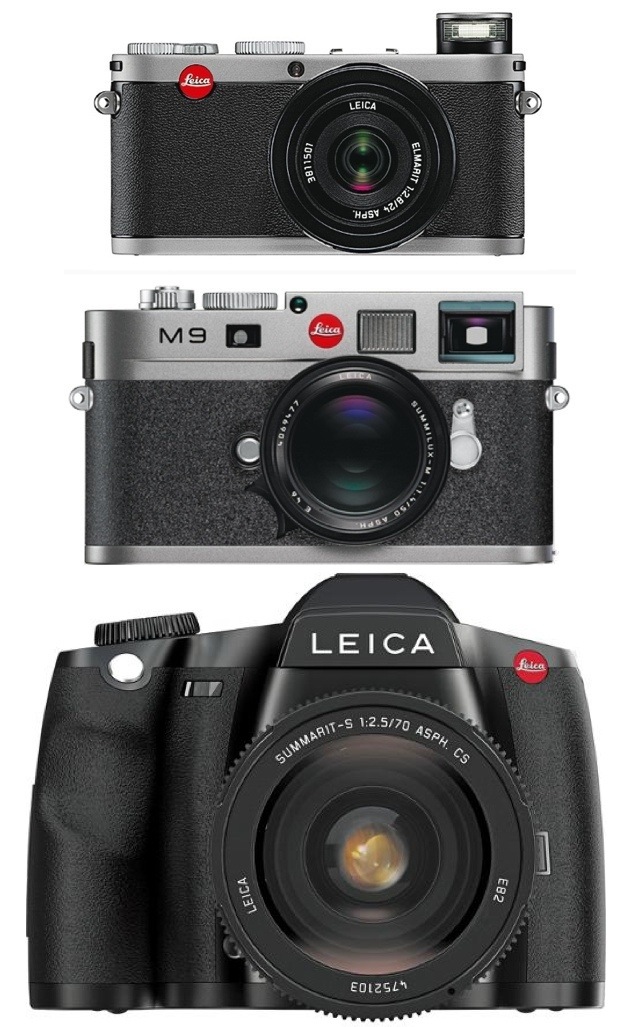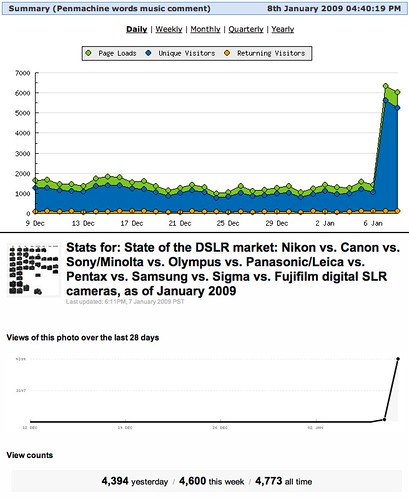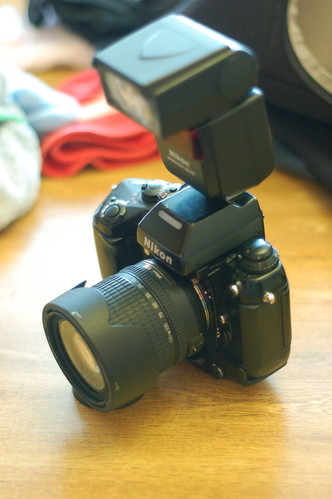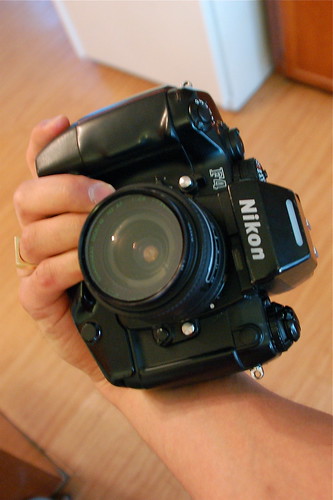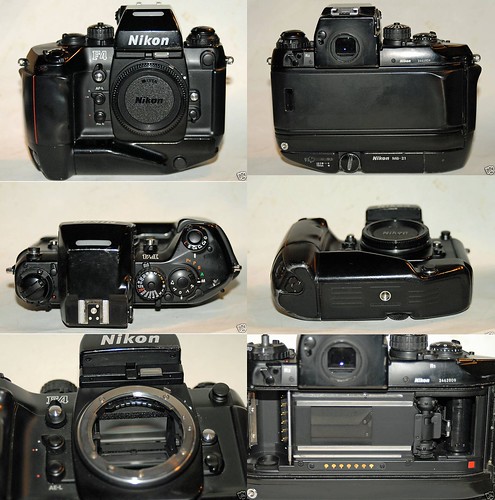Penmachine
13 September 2009
It looks like Leica is back, finally
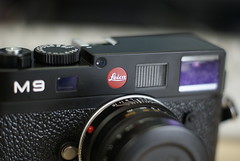 Back in the early 20th century, Leica cameras were the first to make 35 mm film practical for still photography (instead of movies). For decades, they defined well made, technically innovative photographic tools. But since the autofocus and digital revolutions of the 1980s and 2000s, Leica seemed to lose its way. Though the company made partnerships with Minolta and, more recently, Panasonic—repackaging Panasonic cameras as Leicas with a few cosmetic and firmware changes, and charging a lot more money for the name—its flagship German-made SLR and rangefinder cameras fell behind the rest of the industry.
Back in the early 20th century, Leica cameras were the first to make 35 mm film practical for still photography (instead of movies). For decades, they defined well made, technically innovative photographic tools. But since the autofocus and digital revolutions of the 1980s and 2000s, Leica seemed to lose its way. Though the company made partnerships with Minolta and, more recently, Panasonic—repackaging Panasonic cameras as Leicas with a few cosmetic and firmware changes, and charging a lot more money for the name—its flagship German-made SLR and rangefinder cameras fell behind the rest of the industry.
Some professionals continued to use Leica cameras, mostly because of the superb lenses, but among amateurs and enthusiasts, the brand became more of a cult, with its extremely high-priced cameras and lenses fetishized by collectors, but used less and less by regular people taking pictures. In 1982, Leicas were the official cameras taken by the first Canadian expedition to reach the summit of Mt. Everest. Almost 30 years later, it would be hard to imagine such an expedition making a similar choice.
Yes, today's popular cameras (amateur and professional) include a lot of what the Leica Man would call superfluous. But even hard-core photographers—or especially them—now demand autofocus, intelligent computerized exposure metering, and state-of-the-art digital capture. Leica, in contrast to Japanese latecomers like Canon, Nikon, and even Sony, could offer none of these things. Technically, Leica's bulletproof M-series rangefinders were stuck in the '60s, and their R-series SLRs in the '70s. For the huge amounts of money Leica charged, their digital offerings like the crop-frame M8 rangefinder and Modul R digital back seemed (quite literally for the Modul R) like bolt-on afterthoughts.
But this week, Leica introduced these:
They are the new Leica X1 compact camera ($2000 USD), M9 full-frame digital rangefinder ($7000 USD), and S2 medium-format digital SLR ($22,000 USD). (The X1 and M9 are just announced; the S2 first appeared last year, but only now is getting near release, with an actual price.)
No, I did not accidentally add an extra zero to those prices. Leicas remain among the most expensive still cameras available to those outside the military, space programs, and specialized technical and scientific fields. Their lenses, if you can believe it, are even more upscale and (many say) of unsurpassed quality. For the M series rangefinder cameras, a "low end" f/2 Summicron 50 mm is $2000 USD, while its big brother, the top-of-the-line f/0.95 super–low-light Noctilux 50 mm is $10,000 USD. The S-series lenses start at $4500.
And yet, for once, these cameras are unique and innovative. All three are assembled in Germany, to start. The X1 is probably still overpriced, but it does include a genuine Leica lens and an unusually large (and thus low-noise) sensor for a compact camera. The M9 is, for many aficionados, the holy grail they've been waiting for since digital cameras became mainstream: a Leica rangefinder, of the same dimensions and metallic heft of its predecessors, fully compatible with nearly every Leica M lens made since 1954, yet with a full-frame 18-megapixel digital sensor like those in high-end digital SLRs.
The S2, while well out of reach of any normal photographer (even those who might consider an M9), is the really unusual one: Leica's first real foray into medium-format photography. The sensor is more than 50% larger than a full-frame 35 mm chip, but the camera itself is similar in size to Canon's smaller-sensored 1D and 1Ds Mark III and Nikon's D3 and D3x cameras, and has a much simpler interface than other modern DSLRs.
The S-series lenses are huge and heavy, but until now (with the marginal exception of the Mamiya ZD), digital medium-format photography hasn't had the convenience of autofocus SLR handling and simplicity. From the initial quick impressions of people who've tried it, Leica may have created a winner for high-end studio and landscape photographers in the S2. And, for the first time in many years, Leica has a truly modern camera that no one else can match. For now.
Labels: canon, geekery, leica, nikon, photography, sony
07 January 2009
Are there perhaps too many digital SLRs on the market?
One way to get lots of people to see a photo of yours on the image sharing site Flickr is to take a good picture. That requires talent, skill, and dedication. A few of my pictures have become popular simply because they're good photographs—at least I think so.
But my most popular pictures on Flickr aren't like that at all. They're nerdy: pictures of wacky guitars or geek conferences, of old computers or Linux running on a Mac.
And what do you do to attract huge numbers of viewers and comments and favourites? Simple, go full nerd: just make a picture of a whole bunch of cameras and encourage people to argue about them. More than 38,000 views in six months, 208 favourite votes, and dozens and dozens of comments:
Old image of almost 25 cameras
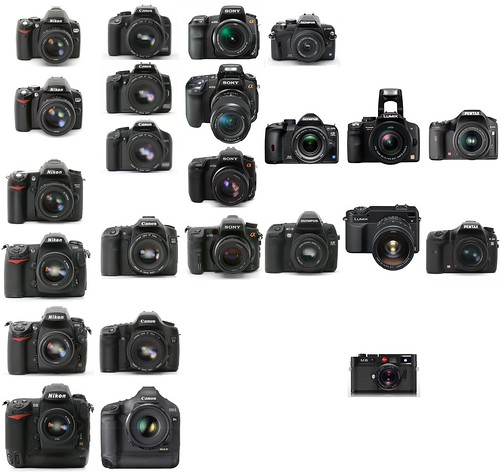
State of the DSLR market - June 2008 (old)
An earlier attempt of mine at the same thing even had commenters threatening to kill each other about the kind of camera they like! But my favourite comment was from Axl Van Goks: "I like the black one with the buttons and stuff."
Since the digital camera market changes like crazy, my big collage from June 2008 was out of date within weeks. I waited for all the pre-Christmas camera introductions to shake out, and now I've made a new version that includes all the current digital SLR cameras I could find (almost 40) from Nikon, Canon, Sony, Olympus, Pentax, Panasonic, Leica, Samsung, Sigma, and Fujifilm:
New image of almost 40 cameras
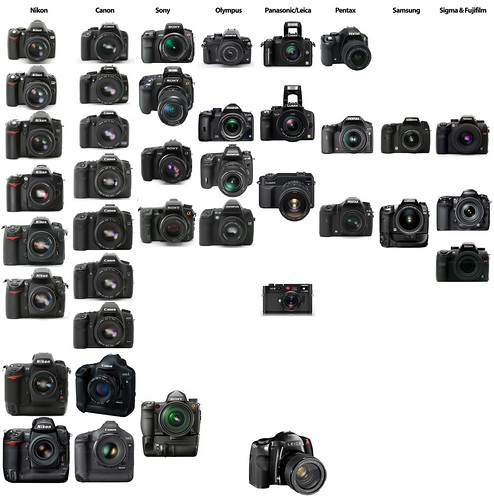
State of the DSLR market - January 2009 (new)
I expect the arguing to begin soon in the comments. The picture has 139 views and 4 favourites since I posted it three and a half hours ago. And yes, yes, I know, I know: they're not all strictly SLRs, but I think they're all of interest to SLR buyers.
Ah, art. Have at it.
UPDATE: My thesis appears to be correct. As a rule of thumb, the more cameras you put in a picture on Flickr, the more popular it is:
Links from John Gruber and 37signals didn't hurt either.
Labels: canon, controversy, flickr, geekery, leica, linkbait, nikon, olympus, panasonic, pentax, photography, sony
16 October 2008
Links of interest (2008-10-16):
I'm still doped up on Tylenol 3's and pretty tired post-surgery, so am not up for much thinking or original posts. I'm also contemplating email bankrupcy again, mere months after my last one, as my inbox creeps up to 800 once more. Sigh. Anyway, here's some interesting stuff:
- What if all movies had cell phones? (There's a good reason No Country for Old Men was set in 1980, by the way.)
- A worthy quote in this electional season: "I like to pay taxes. With them I buy civilization." - Oliver Wendell Holmes (though it may be a folksier recasting of "Taxes are the price we pay for a civilized society").
- "Hey news executives! Try this newsroom pop quiz: Give each staff member a pencil and tell everyone to stop what they're doing and write out the tag that creates a hypertext link." (via Dan)
- Andrew Sullivan rounds up quotes from a number of last night's press and blogger reactions to the final McCain-Obama debate.
- Also from Sullivan, it's a bit sad how well this video reflects the approach of the McCain campaign right now.
- While Leica's upcoming S2 camera is quite large (especially the lenses) for a digital SLR, it has a medium-format size sensor, meaning that it is smaller and probably more ergonomic than most of its direct competitors, and that even the rumoured €10,000–20,000 price isn't as insane as it sounds. Nevertheless, the cost of a reasonably complete S2 system when it's released next year will rival that of a condominium. It also bodes well for future "lower end" (for Leica, at least) cameras from this legendary manufacturer.
- What's it like to write other people's term papers for a living? (via Kottke)
- The web comic Basic Instructions makes me laugh almost every single time a new one comes out.
- Vancouver locals Buzz Bishop and Darren Barefoot accurately summarize the Canadian election held this week, in which nothing much changed. The result (as I discussed earlier) bodes poorly for our country's environmental and climate policy, which is one subject we can't afford to waste time on, unfortunately.
Labels: environment, film, leica, linksofinterest, movie, news, photography, politics, school, telecommunications, web, writing
09 July 2008
The monster film camera arrives
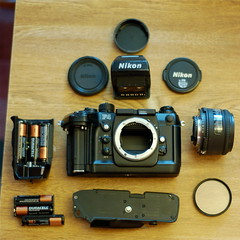 Yesterday I got an online notice that my eBay purchase Nikon F4 film camera had cleared Canada Customs. I thought that might mean it would take a few more days to arrive, but the Canada Post truck showed up with it this afternoon. I made some camera nerd unboxing photos with my digital SLR if you'd like to see them.
Yesterday I got an online notice that my eBay purchase Nikon F4 film camera had cleared Canada Customs. I thought that might mean it would take a few more days to arrive, but the Canada Post truck showed up with it this afternoon. I made some camera nerd unboxing photos with my digital SLR if you'd like to see them.
I have to say this: wow. For a 20-year-old design, the F4 is an amazing camera. It weighs a ton, because it's both huge (freakin' huge) and made of thick metal under the rubber covering, but it feels great in my hands. It's remarkably responsive, easy to figure out for anyone who grew up with the dials, knobs, and buttons of an analog SLR, and fast.
I'd also forgotten what it's like to look into a bright, full-frame, 100%-coverage viewfinder with minimal clutter. Compared to the finder view in my D50, it's expansive, and having only one central autofocus point plus a couple of etched circles (to show where the different types of light metering act) means there's a lot less other stuff busying up the view.
All my Nikon-mount lenses fit and work—even ones with technology designed more than a decade after the camera ceased production—although the newest, designed for a smaller digital sensor and lacking an aperture ring, is limited and vignettes heavily. Most surprising, my SB-600 flash functions pretty much fully, including reading lens focal length, working with through-the-lens (TTL) metering, and acting as an autofocus illuminator (which the camera otherwise lacks).
Running the motor drive at top speed yields a full paparazzi kssht-kssht-kssht-kssht-kssht, much faster than my lower-end D50 digital SLR from 2006. Autofocus is surprisingly quick too, though not up to complete modern standards. Unlike my D50, the F4 has mirror lockup, dedicated buttons for exposure and focus lock, depth of field preview, and an eyepiece shutter on a removable viewfinder pentaprism.
I loaded the F4 up with some Ilford black-and-white film and took it along while my younger daughter and I walked to the store and the park this sunny afternoon. I also picked up a new camera strap at Kerrisdale Cameras, since none of my current ones have the keychain-style metal rings at the ends that work with the F4's teeny tiny metal strap connectors. And I'll have to track down a rubber eyepiece ring, since that's the only stock item missing from the camera.
Of course, the key frustration with any film camera is that you can't see your pictures right away—I'll have to wait to finish the roll and get it processed, just like I did my entire picture-taking life from childhood until I bought my first digital camera in 2002. And yet that also forces me to think a bit more: How will this look in black and white (for this roll)? What's the best angle for this shot (I can't waste film trying a bunch of different ones)? What works in this light at this film ISO setting (since I can't adjust that)? What kind of depth of field and shutter speed do I want? And so on.
Perhaps the greatest pleasure comes from something I haven't had in more than 15 years: an SLR camera with analog controls for every feature, not multifunction digital buttons and mode dials and four-way controllers and LCD screens. Other than the lack of a manual film winding lever, and the info LCD inside the viewfinder, the F4 has the same kind of excellent tactile controls and analog displays photographers relied on for decades, from the first Leica rangefinder shooters to the astronauts walking on the moon.
There's definitely a difference adjusting the lens opening with an aperture ring on the lens, and the shutter speed with a dedicated dial on the top of the camera, than with the one or two thumbwheels on the handgrips of modern digital (and even film) SLRs. In the digital era, only the otherwise imperfect Panasonic Lumix DMC-L1 and Leica M8, with their retro aesthetic, offer anything like that.
Obviously, I don't have any of my photos from the F4 yet. But I'll link them up when I do.
Labels: film, gadgets, geekery, leica, moon, nikon, photography
03 July 2008
State of the digital SLR market: Nikon, Canon, Sony, Olympus, Panasonic, Pentax, and Leica
Last year I created a little composite image of the various interchangeable-lens digital single-lens reflex (DSLR) cameras then available from Nikon and Canon, the two leading camera manufacturers. It turned out to be one of my most popular pictures at the Flickr photo sharing service, of course because photo enthusiasts like to argue about Canon vs. Nikon almost as much as Mac and PC people do about their computers.
It became out of date pretty fast, with models discontinued and new ones introduced. But people kept looking at the image and commenting. So I decided to go further and create a similar composite visual chart of DSLRs currently available, as of the end of June 2008, from all the major camera makers: Nikon, Canon, Sony/Minolta, Olympus, Panasonic/Leica, and Pentax. The pictures are all the companies' publicity photos, sometimes sourced directly from their websites, sometimes from others such as DP Review and DC Resource:
No wonder people are confused about which camera to buy! Prices here range from around $500 (with lens) to about $8000 (no lens). The smallest cameras in this bunch are the Leica M8 (off by itself on the lower right, and not an SLR, see below) and the Olympus E-420 (top of the fourth column, see this review for real-life size comparison photos). The heaviest are the two pro monsters, the Nikon D3 and Canon 1Ds Mark III, in the lower left.
I have excluded a few other makers, such as Fuji and Sigma, and rebadged models from Samsung (nearly the same as some Pentaxes) and Leica (almost identical to the Panasonics). These images reflect the main line of SLRs (plus the M8) as of this writing.
Relative camera sizes are not exact. The positions of the various models vaguely reflect my impressions of a combination of price, features, and market segment. That's quite subjective, so you could easily argue with my placement of some of them. Take the image as a general guideline. Look down the columns to see how different cameras from a single manufacturer compare from low-end to high-end; look across the rows to see roughly comparable cameras (in features, price, or both) from different makers that compete with one another.
Nikon and Canon are (currently) alone in providing full-frame size semi-pro and professional DSLRs: the D700, EOS 5D, D3, and EOS 1Ds Mark III. The Leica M8 is the real outlier—not an SLR at all, but a digital version of the classic Leica M rangefinder; I put it here because a significant number of photographers looking at the high-end Nikons and Canons might also consider it.
The most crowded market segments are the introductory level (with something, and sometimes several confusing models, from every manufacturer), and the midrange enthusiast section (with some interesting choices like the D80, D300, 40D, A700, E-3, DMC-L1, and K20D). With all the choices, this might be the most interesting time in the history of single-lens reflex cameras, certainly in the digital era.
I also left out some models. Canon's pro sports-focused 1D Mark III, which looks and works essentially identically to the 1Ds Mark III, is one—the difference is that the "s" indicates a larger full-frame sensor (Canon needs a serious simplification of its naming scheme). The Nikon D40 is also the same body as the D40x (and the D60), but with a lower-resolution sensor. Some of these models, such as the D40x and the Canon XTi, may be theoretically discontinued now or soon, but remain widely available.
Finally, there will probably soon be updates rendering this composite chart at least partially obsolete. Canon is expected to replace the three-year-old EOS 5D any old time, Nikon might do the same for the similarly aged D80, Sony may release a full-frame DSLR (since they make Nikon's full-frame sensor, I believe), and Nikon could bring out a D3x or similar model with a higher-resolution full-frame sensor like the 1Ds Mark III. I'll let you know.
Labels: canon, gadgets, geekery, leica, nikon, olympus, panasonic, pentax, photography, sony
02 July 2008
Goin' back to Cali... I mean film
 I've been writing more about photography lately, largely because I've been doing more of it, especially weird stuff like high dynamic range pictures—it's a hobby I can play with even when I'm on chemotherapy or otherwise ill. I've been happy using my Nikon digital SLR and small lens collection.
I've been writing more about photography lately, largely because I've been doing more of it, especially weird stuff like high dynamic range pictures—it's a hobby I can play with even when I'm on chemotherapy or otherwise ill. I've been happy using my Nikon digital SLR and small lens collection.
This week, Nikon introduced a new high-end DSLR, the D700. Of course it was fun to read about, but my D50 is just fine; the D700 is far beyond anything I need to use, and at $3000 is well out of any price league I'm likely to be in for a long time.
One thing I have been wanting to try is cross processing, of which I've seen some great examples in Kris Krug's photostream at Flickr. Cross processing, however, requires a film (not digital) camera. It usually involves taking slide film and instructing your film lab to process it using the same chemicals used for print film. Like HDR, cross processing creates some bizarre, surreal effects, as in these pictures from Kris. Taking some black-and-white shots might be fun too.
However, my last film SLR, a Nikon F601, died several years ago (the film transport crapped out while we were taking family Christmas pictures). I still use a couple of the lenses I bought for it on my digital D50, but I currently have no way to take film photos. Fortunately, now that we're well into the 21st century and the digital era, used film cameras are ridiculously cheap. As long as you're not going for a Leica or a Nikon F6, it's actually difficult to spend more than a couple of hundred bucks on even a very nice older film body.
So yesterday, Canada Day, I hunted around on eBay a bit and found this:
It is a used, slightly but deliciously worn Nikon F4s, which was Nikon's revolutionary top-of-the-line professional camera from 1988 to 1996, when it was replaced by the F5. The photographer at my wedding in 1995 (likely the year the particular one above was made) used the F4, as did many photojournalists, sport photographers, and other professionals a couple of decades ago. I put in a bid for the F4s above, and I won.
I've tried out a used F4 in a local camera store before, and unless you've handled a top-shelf professional DSLR—film or digital—the heft of the thing is a little hard to describe. Like the current flagship Nikon D3 or Canon 1D, it is large, extremely solid, heavy, and yet still very nice to hold. While it is a fully electronic, autofocus and autoexposure camera, all the controls on the F4 are analog: dials, buttons, and levers. There is no external LCD panel or menu system. It feels like you could hammer nails or fend off a robber with it and keep taking pictures afterwards.
Although it was designed when I was in my early years at university, there are numerous ways the F4 outperforms any camera I've ever owned, including its fast and precise continuous shooting frame rate (5.7 frames per second, almost twice as fast as my D50), and at least basic compatibility with (as far as I can tell) every F-mount SLR lens Nikon has ever made—from the earliest manual-focus models from 1959 to the latest autofocus ones from 2008—including all the ones I own. The F4 is midway through the line of professional Nikon F cameras made over the past 50 years:
All this for just over $200. That's about the price of a nice pair of boots, a decent set of men's clothes, an 8 GB iPod nano, or a low-end zoom lens today; $100 cheaper than Nikon's current low-budget student manual SLR, the FM10; about a third as much as the current intro-level Nikon or Canon digital SLRs (or what I paid for the D50 in 2006); and a mere 10% of the $2000 cost of a new F6—or of the F4 itself at introduction in September 1988.
My new/old F4 should arrive in a week or two. Now the question is: where do I buy slide or B&W film in Vancouver these days?
Labels: film, gadgets, geekery, leica, nikon, photography
18 June 2008
Buying your first serious digital SLR camera
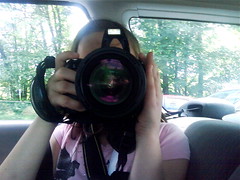 I get emails out of the blue sometimes, and yesterday a guy who found me via Flickr asked my advice on buying his first serious digital SLR (single-lens reflex) camera. He's already quite a good photographer, with a keen eye, and he's trying to decide between the Nikon D300 and Canon EOS 40D.
I get emails out of the blue sometimes, and yesterday a guy who found me via Flickr asked my advice on buying his first serious digital SLR (single-lens reflex) camera. He's already quite a good photographer, with a keen eye, and he's trying to decide between the Nikon D300 and Canon EOS 40D.
He likes the Canon's interface, but prefers the features of the D300, as well as the more vivid colours it produces (at least in JPEG mode). He wants low noise, good low-light performance, and good ability to take landscapes, high dynamic range (HDR) photos, and macro (closeup) pictures.
When you're starting out buying an SLR, what you're doing is committing yourself to a camera system, particularly with lenses. Chances are you will keep and use the lenses for much longer than you use that camera. For instance, I have a Nikon D50 I bought in 2006, but my lenses include a zoom that I bought in 1995 for my old film Nikon, and which still works great. I've been using Nikon SLRs since the early 1980s—had I chosen Canon or some other camera back then, I'd probably still be using that brand, just because of the inertia.
Both Nikon and Canon are good choices—but don't forget Pentax's K20D (Pentax provides some of the best values in both SLRs and quality lenses these days) and even Sony's A700 (Sony took over Minolta's camera business, and offers very nice Zeiss lenses too, some of the best available). I'm not a fan of the four-thirds system from Olympus and Panasonic/Leica, but you might like it.
The D300 is about 50% more expensive than the 40D (around $1800 Cdn vs. $1300 Cdn), so that might make the decision for many people. (The closest competing Nikon is actually the aging D80.) One way that price difference could affect your decision might be with lenses: if you can only afford an expensive body (like the D300) with cheaper lenses, you'd be better off getting a less expensive body (like the 40D) with better lenses like Canon's top-end L series. Again, the lenses will be around your kit longer than the body.
And for any camera you get, rather than buying yourself a standard zoom lens, I would recommend getting one or two good-quality prime (non-zoom) lenses instead. They are better optically, faster (i.e. have a larger maximum aperture letting in more light), and will also make you think about your compositions more carefully.
So I said to my questioner that if he doesn't have a brand preference for other reasons, and if he can afford the Nikon D300 with a quality lens or two, then I'd recommend it over the Canon 40D. The D300 offers excellent low-light performance, an amazing LCD screen (much better than anything Canon has), and lots of other features. Not that there's anything wrong with the 40D, but by most objective measures the D300 is superior.
As far as lenses go, if I were starting from scratch, I'd get a basic fast prime like the $140 Nikon 50 mm f/1.8 or the $500 digital-only Sigma 30 mm f/1.4. For a second lens, I'd look at either a general-purpose stabilized zoom like Nikon's well-reviewed $750 18-200 mm, or (more likely in my case) a moderate telephoto prime that can also act as a macro lens, such as Nikon's $900 Micro-Nikkor 105 mm f/2.8. If I had more money to spend, I might get both of those, or go crazy and buy the $1500 manual focus Zeiss Makro-Planar 100 mm f/2.
Canon has similar standard prime, telephoto-style macro, and zoom lenses. So do Pentax (prime, macro, zoom) and Sony/Zeiss (prime, macro, zoom, or Zeiss zoom).
It would be a pleasant luxury to be starting an SLR system from scratch, and to have maybe $4000 to spend on it. But no matter how you start, if you're a photography enthusiast, you'll get more lenses and other accessories (flash, battery grip, tripods, etc.) over time. Just don't cheap out with your lenses to start, and you'll be happier in the long run.
Labels: canon, gadgets, geekery, hdr, leica, macro, nikon, olympus, pentax, photography, sony
01 April 2008
Camcorders have changed in 10 years
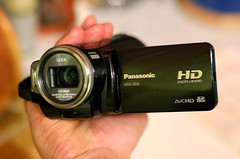 Over at Inside Home Recording, we recently started IHR TV, additional short video tutorials that augment our regular longer audio podcasts. As part of that effort, we used some of the money we get from sponsors and advertisers to buy two Panasonic HDC-SD5 high-definition camcorders. (Bought online, two of them cost only very slightly more than a single one at local retail stores.)
Over at Inside Home Recording, we recently started IHR TV, additional short video tutorials that augment our regular longer audio podcasts. As part of that effort, we used some of the money we get from sponsors and advertisers to buy two Panasonic HDC-SD5 high-definition camcorders. (Bought online, two of them cost only very slightly more than a single one at local retail stores.)
The last camcorder my family had, which sits half-broken in our basement, was an old Samsung analogue Video 8 tape-based machine, from 1998. Given the improvements in other consumer electronics, from personal computers to digital cameras to televisions, over the past decade, I'm not sure why I'm so surprised at this little camcorder, but it's a remarkable machine.
Consider, first, that it can record at 1920x1080i "Full HD" resolution, with something like six times the detail of our old camera, using a very nice mechanically stabilized Leica lens. It stores that information not on tapes, but on the same SD cards used by the still cameras and audio recorders we have at the house. The whole camera is only about a third larger, and almost exactly the same weight, as the old Samsung battery—being smaller than my hand, it almost gets lost among its accessories in our camcorder bag.
Perhaps most remarkably, Panasonic has put real thought into simplifying how the camera works. There aren't many buttons and dials, they're clearly labeled, and everything is easy enough to figure out that the manual (which is long and detailed, but only averagely written) is only necessary for some of the more detailed settings. The SD5 even takes pretty nice still photos.
Those huge HD videos, however, require a lot of horsepower to edit: only one of the computers in our house (my Intel MacBook) will even import the massive AVCHD video files directly. And, following the trend in pocket still cameras, there is no longer a viewfinder: you have to look at the pop-out LCD screen to frame your shots. Like too many consumer electronics today, the camera also comes festooned with garish and difficult-to-remove little stickers advertising its features, the software it comes with, and so on. I removed those immediately.
It lacks a couple of pro features that would be useful: the only sound-in is from the stereo microphone, so you can't connect an external mic or line-in sound, which is something I'll work around with a separate audio recorder if needed. (Very cleverly, though, the microphones can focus in on your subject as you zoom the lens, and electronically filter out some wind noise. Nifty.) Similarly, while it comes with cables to send sound and video out to a TV or other device, you can't record video from any source other than the lens, so I can't, for instance, use it to digitize any of our old footage.
With devices like these, it's no wonder people can now smuggle broadcast-quality video out of the world's war zones and trouble spots. We'll see what I can do with this camera and my mediocre video skills for our modest little podcast.
Labels: geekery, leica, panasonic, photography, podcast, video
19 September 2007
Leica's SLR lets you swap film and digital backs
 The Leica camera company (there's a loving profile here) takes an interesting approach with their R9 SLR camera: you can choose either an analog film or a digital "Modul R" back for the same camera.
The Leica camera company (there's a loving profile here) takes an interesting approach with their R9 SLR camera: you can choose either an analog film or a digital "Modul R" back for the same camera.
No other manufacturer offers anything like that for a 35 mm SLR. Of course, the R9 by itself costs about $3200 USD (no lens—those cost thousands too, and I don't think any are autofocus), with the 10-megapixel Modul R back running another $6000 (!) or so. That's even crazier than the latest Nikon and Canon DSLR beasts.
But you know, it is Leica. If I had $9000+—USD—okay, with lenses, probably $12,000 just to get started—to spend on a DSLR (and I sure don't), I might consider the R9 Modul R over the Canon 1-Ds Mark III, just for the pure snob factor—and the much cooler name.
UPDATE: Here is the Leica M8, a more traditional rangefinder-style Leica, now in digital form, which I would very much like to try, though probably not own, someday:
It's quite controversial and very pricey ($5000 USD, no lens), but has great value for some people. For some it might even keep them alive (or at least get better candid photos) because it is much less obtrusive than an SLR.
Labels: canon, geekery, leica, nikon, photography
